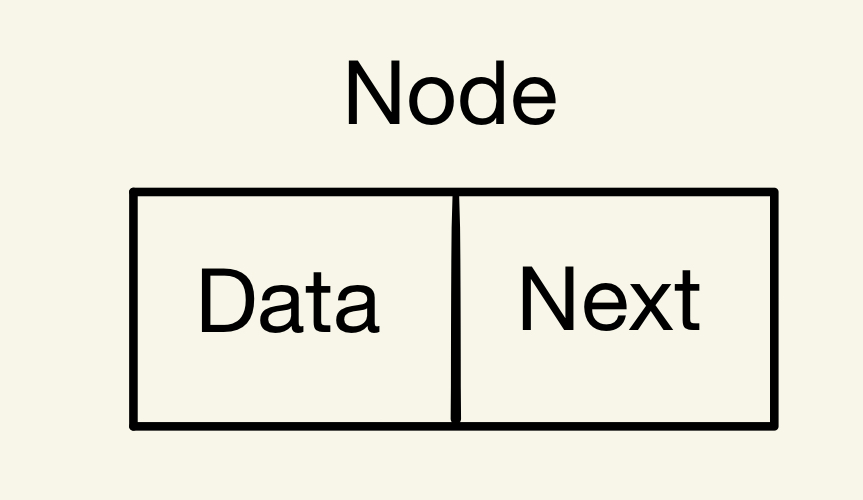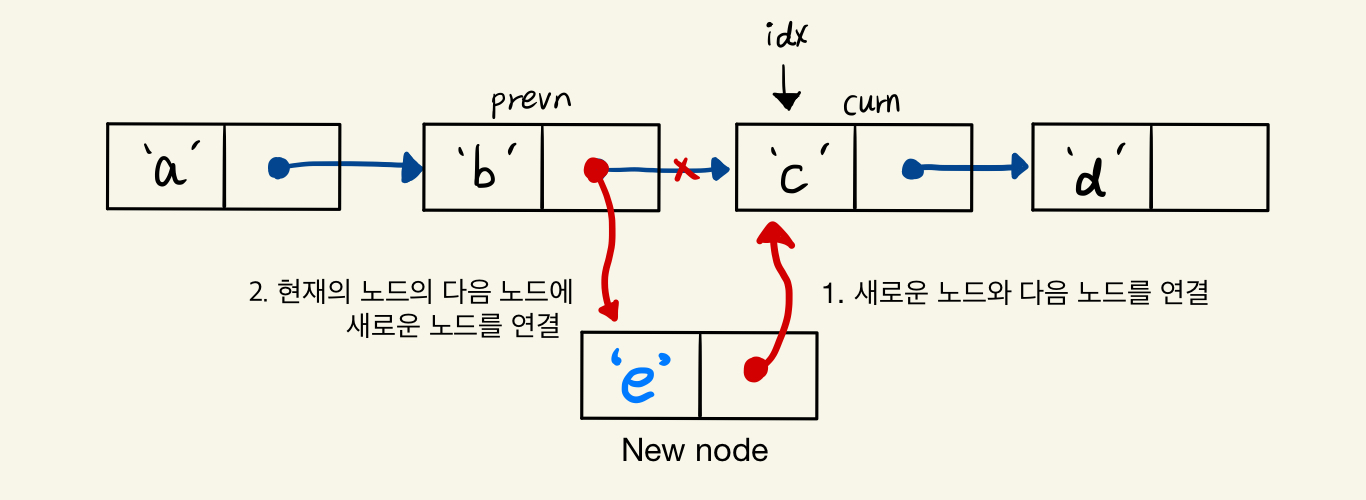Linked list(연결 리스트)는 (데이터와 다음 노드의 주소를 담고 있는) 노드들이
한 줄로 연결되어 있는 방식의 자료 구조입니다.

연결되는 방향에 따라, (1) Singly linked list (단일 연결 리스트), (2) Doubly linked list (이중 연결 리스트), (3) Circular linked list (환형 연결 리스트)가 있습니다.
이 포스팅에서는 Linked list와 Singly Linked list 의 특징을 알아보고
파이썬으로 Singly Linked list의 삽입, 삭제, 조회를 구현해보도록 하겠습니다.
# Linked list란?
Linked List는 데이터를 노드의 형태로 저장합니다. 노드에는 데이터와 다음 노드를 가르키는 포인터를 담은 구조로 이루어져 있습니다.

Linked list는 Array 처럼 선형 데이터 자료구조이지만, Array는 물리적인 배치 구조 자체가 연속적으로 저장되어 있고 Linked list는 위의 노드의 Next 부분에 다음 노드의 위치를 저장함으로써 선형적인 데이터 자료구조를 가집니다.
Python 내장 함수의 시간 복잡도에서 List의 삽입과 삭제의 시간복잡도가 O(n)이 걸리는 것은 배열이 물리적인 데이터의 저장 위치가 연속적이어야 하므로 데이터를 옮기는 연산작업이 필요하기 때문입니다. 하지만 Linked List는 데이터를 삽입, 삭제할 경우, 노드의 Next 부분에 저장한 다음 노드의 포인터만 변경해주면 되므로 배열과 비교하였을 때 linked list가 효율적으로 데이터를 삽입, 삭제할 수 있습니다. 그러나 이러한 안타깝게도 Linked List에서 특정 위치의 데이터를 탐색하기 위해서는 첫 노드부터 탐색을 시작하여야 합니다. 그 시간이 O(n) 만큼 걸리게 되므로 탐색에 있어서는 배열이나 트리 구조에 비해 상대적으로 느리다고 할 수 있습니다.
# Linked list의 장점과 단점은요
Linked lsit의 장점은,
(1) Linked list의 길이를 동적으로 조절 가능
(2) 데이터의 삽입과 삭제가 쉬움
Linked list의 단점은,
1) 임의의 노드에 바로 접근할 수 가 없음
(2) 다음 노드의 위치를 저장하기 위한 추가 공간이 필요함
(3) Cache locality를 활용해 근접 데이터를 사전에 캐시에 저장하기가 어려움
(4) Linked list를 거꾸로 탐색하기가 어려움
※ cache locality : 대부분 프로그램은 한번 사용한 데이터를 다시 사용할 가능성이 높고, 그 주변의 데이터도 곧 사용할 가능성이 높은 데이터 지역성을 가지고 있습니다. 데이터 지역성을 활용하여 메인 메모리에 있는 데이터를 캐시 메모리에 불러와 두고, CPU가 필요한 데이터를 캐시에서 먼저 찾도록 하면 시스템 성능을 향상시킬 수 있습니다.
# 단일 연결 리스트 구현하기
단일 연결 리스트는 각 노드에 자료 공간과 한 개의 포인터 공간(다음 노드의 주소를 담는 공간)이 있고, 각 노드의 포인터는 다음 노드를 가리킵니다.
# 삽입

# 삭제

# 파이썬 코드
|
1
2
3
4
5
6
7
8
9
10
11
12
13
14
15
16
17
18
19
20
21
22
23
24
25
26
27
28
29
30
31
32
33
34
35
36
37
38
39
40
41
42
43
44
45
46
47
48
49
50
51
52
53
54
55
56
57
58
59
60
61
62
63
64
65
66
67
68
69
70
71
72
73
74
75
76
77
78
79
80
81
82
83
84
85
86
87
88
89
90
91
92
93
94
95
96
97
98
99
100
101
102
103
104
105
106
107
108
109
110
111
112
113
114
115
116
117
118
119
120
121
122
123
124
125
126
127
128
129
130
131
132
133
|
# Node 클래스 선언
class Node(object):
def __init__(self, data):
self.data = data
self.next = None
# Singly linked list 클래스 선언
class SinglyLinkedList(object):
def __init__(self):
self.head = None
self.count = 0
# Add new node at the end of the linked list
def append(self, node):
if self.head == None:
self.head = node
else:
cur = self.head
while cur.next != None:
cur = cur.next
cur.next = node
# return first index of data in the linked list
def getdataIndex(self, data):
curn = self.head
idx = 0
while curn:
if curn.data == data:
return idx
curn = curn.next
idx += 1
return -1
# Add new node at the given index
def insertNodeAtIndex(self, idx, node):
"""
A node can be added in three ways
1) At the front of the linked list
2) At a given index.
3) At the end of the linked list.
"""
curn = self.head
prevn = None
cur_i = 0
# (1) Add 0 index
if idx == 0:
if self.head:
nextn = self.head
self.head = node
self.head.next = nextn
else:
self.head = node
else:
# (2) Add at given index &
# (3) At the end of the linked list
while cur_i < idx:
if curn:
prevn = curn
curn = curn.next
else:
break
cur_i += 1
if cur_i == idx:
node.next = curn
prevn.next = node
else:
return -1
# Add new node before the given data
def insertNodeAtData(self, data, node):
index = self.getdataIndex(data)
if 0 <= index:
self.insertNodeAtIndex(index, node)
else:
return -1
# Delete data at given index.
def deleteAtIndex(self, idx):
curn_i = 0
curn = self.head
prevn = None
nextn = self.head.next
if idx == 0:
self.head = nextn
else:
while curn_i < idx:
if curn.next:
prevn = curn
curn = nextn
nextn = nextn.next
else:
break
curn_i += 1
if curn_i == idx:
prevn.next = nextn
else:
return -1
# Empty linked list
def clear(self):
self.head = None
# 출력
def print(self):
curn = self.head
string = ""
while curn:
string += str(curn.data)
if curn.next:
string += "->"
curn = curn.next
print(string)
if __name__ == "__main__":
sl = SinglyLinkedList()
sl.append(Node(1))
sl.append(Node(2))
sl.append(Node(3))
sl.append(Node(5))
sl.insertNodeAtIndex(3, Node(4))
sl.print()
print(sl.getdataIndex(1))
print(sl.getdataIndex(2))
print(sl.getdataIndex(3))
print(sl.getdataIndex(4))
print(sl.getdataIndex(5))
sl.insertNodeAtData(1, Node(0))
sl.print()
|
cs |
'Data structure' 카테고리의 다른 글
| Python으로 구현하는 자료구조 : Linked List (3) Circular linked list (0) | 2019.05.10 |
|---|---|
| Python으로 구현하는 자료구조 : Linked List (2) Doubly linked list (0) | 2019.05.09 |
| Python으로 구현하는 자료구조 : Stack (0) | 2019.03.31 |
| Python으로 구현하는 자료구조 : Array (0) | 2019.03.30 |
